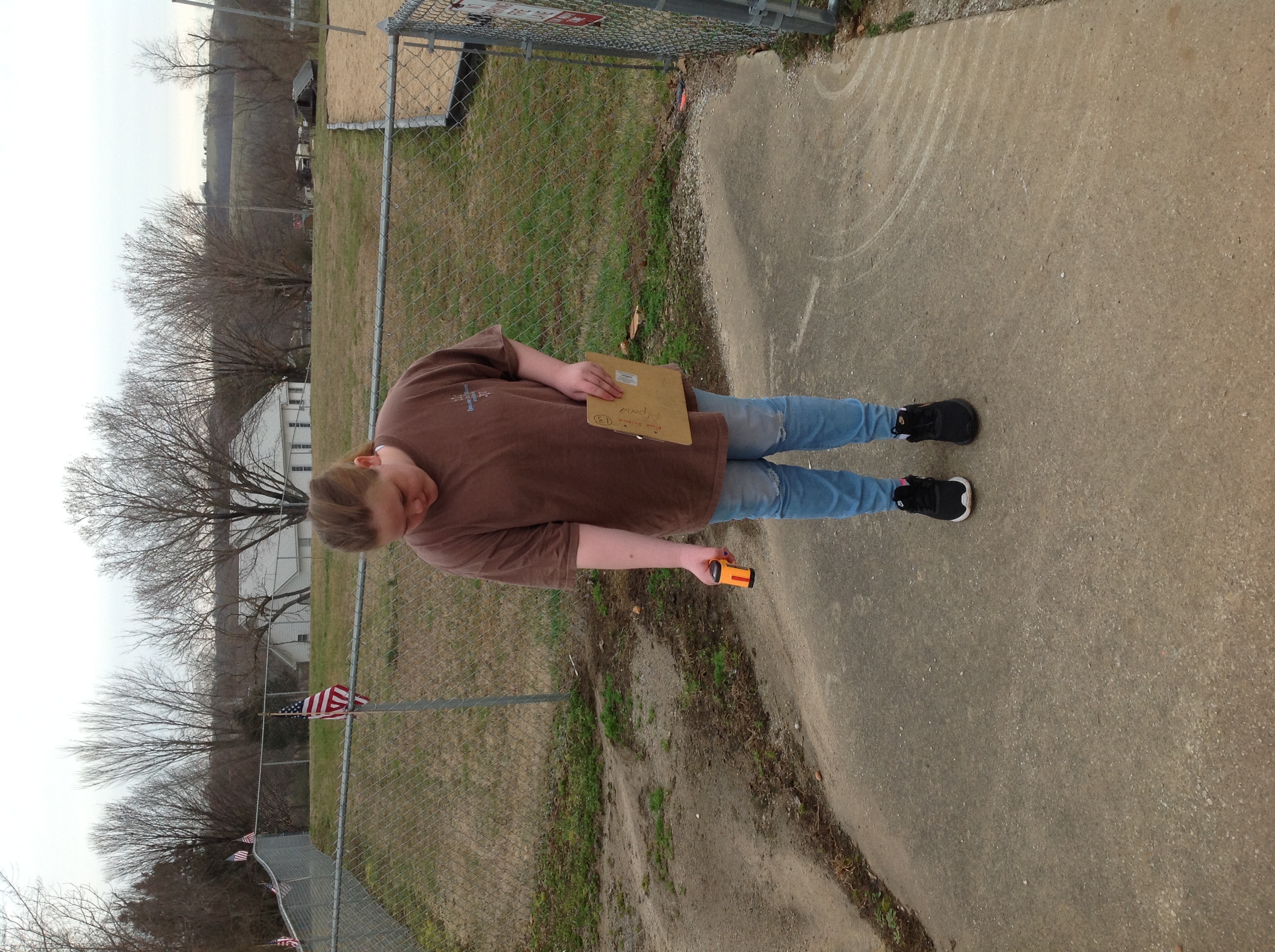RE: Cool Concrete - 5th Grade - 2020 SRS - 2020 SRS
GLOBE Breadcrumb
- Home >
- 2020 SRS
Open social media sharing options menu
 Share
Share
GLOBE Side Navigation
Site Name
2020 Student Research Symposium (SRS)
Message Boards
- Home
- RE: Cool Concrete - 5th Grade
0
Project Title: "Cool Concrete"
School Name: Alpena Elementary/Middle School
Teacher Name: Roger Rose
Student Name: Annabelle Melton
Grade Level: 5th grade
Project Description: A study using the GLOBE Surface Temperature Protocol to analyze the temperature on six different surfaces.
Abstract: This project is the result of an investigation conducted using the GLOBE Surface Temperature Protocol to analyze the surface temperature of six different surfaces. It is predicted that the sand surface temperature will be the lowest and the asphalt surface temperature will be the highest compared to the average air temperature. During the GLOBE solar noon data collection window, the researcher collected surface temperature on six different surfaces close to the school's GLOBE weather station site: short grass, sand, bare ground, concrete, asphalt, and tall grass. An infrared thermometer was used to collect 9 samples for each surface on 5 different days, for a total of 30 Surface Temperature/Cloud Observations and 270 temperatures. Following the GLOBE Surface Temperature Protocol, sky conditions, surface conditions, air temperature, barometric pressure and humidity were collected and submitted to GLOBE. The average air temperature was 14.82*C. The average temperature for short grass was 14.44˚C, sand was 11.82˚C, bare ground was 15,33˚C, concrete was 10.79˚C, asphalt was 15.38˚C, and tall grass was 14.53˚C. The hypothesis was not completely supported by the data. Concrete provided the coldest average temperature, -27% colder than the air. Asphalt had the highest average temperature, +3.7% hotter than the air. The surface temperatures were collected during the winter when the sun's rays were striking the surface at about a 30˚angle. It is predicted that the asphalt would have a much higher percentage of increase in temperature during the summer months, when the sun's rays strike the earth at a more direct angle.
Atmosphere Protocols: Air Temp, Barometric Pressure, Clouds, Relative Humidity, Surface temp.
Language: English
Video URL: https://youtu.be/onHxhWxAaLU![]()
![]()

![]()
School Name: Alpena Elementary/Middle School
Teacher Name: Roger Rose
Student Name: Annabelle Melton
Grade Level: 5th grade
Project Description: A study using the GLOBE Surface Temperature Protocol to analyze the temperature on six different surfaces.
Abstract: This project is the result of an investigation conducted using the GLOBE Surface Temperature Protocol to analyze the surface temperature of six different surfaces. It is predicted that the sand surface temperature will be the lowest and the asphalt surface temperature will be the highest compared to the average air temperature. During the GLOBE solar noon data collection window, the researcher collected surface temperature on six different surfaces close to the school's GLOBE weather station site: short grass, sand, bare ground, concrete, asphalt, and tall grass. An infrared thermometer was used to collect 9 samples for each surface on 5 different days, for a total of 30 Surface Temperature/Cloud Observations and 270 temperatures. Following the GLOBE Surface Temperature Protocol, sky conditions, surface conditions, air temperature, barometric pressure and humidity were collected and submitted to GLOBE. The average air temperature was 14.82*C. The average temperature for short grass was 14.44˚C, sand was 11.82˚C, bare ground was 15,33˚C, concrete was 10.79˚C, asphalt was 15.38˚C, and tall grass was 14.53˚C. The hypothesis was not completely supported by the data. Concrete provided the coldest average temperature, -27% colder than the air. Asphalt had the highest average temperature, +3.7% hotter than the air. The surface temperatures were collected during the winter when the sun's rays were striking the surface at about a 30˚angle. It is predicted that the asphalt would have a much higher percentage of increase in temperature during the summer months, when the sun's rays strike the earth at a more direct angle.
Atmosphere Protocols: Air Temp, Barometric Pressure, Clouds, Relative Humidity, Surface temp.
Language: English
Video URL: https://youtu.be/onHxhWxAaLU

0
From Dr. Dixon Butler: Nice project. I appreciate your straight-forward approach and your following the scientific method. Your presentation is clear. I hope you gained in your ability to approach problems scientifically.
0
Hello Annabelle,
My name is Angela Chandler and I am a geologist with the Arkansas Geological Survey. I enjoyed reading your information and viewing your poster. Your layout is clear and easy to read. I am also impressed with the number of readings you took. Good job. As a follow up you might research why concrete was cooler then the sand on your playground. Even though you received a lot of rain, the water drained easily from the sand. Think about the properties of each. This is a great experiment to teach us about the properties of our environment. Keep up the good work!
My name is Angela Chandler and I am a geologist with the Arkansas Geological Survey. I enjoyed reading your information and viewing your poster. Your layout is clear and easy to read. I am also impressed with the number of readings you took. Good job. As a follow up you might research why concrete was cooler then the sand on your playground. Even though you received a lot of rain, the water drained easily from the sand. Think about the properties of each. This is a great experiment to teach us about the properties of our environment. Keep up the good work!
0
Hello Annabelle.
My name is Dr. Jodi Haney. I am a professor emeritus (which means retired, but still VERY active ;-) at Bowling Green State University in Ohio. My students at the university also collect temperature data using the GLOBE Surface Temperature protocol. Your work is very interesting for sure. How did you choose this topic? Your methods are really solid and follow the GLOBE protocol closely... great! I like that you included all the data obtained from your study and that your conclusions are supported by your findings. Your findings stated as a percentage increase or decreases helps summarize your findings nicely and make good sense for 5th-grade learners since you are using percentages in your math classroom. You show differences between all of the surfaces, even in the fall and winter. Why do you think these differences existed? When you say you hypothesized that asphalt would be much warmer than the air, why did you think so? What is it about asphalt that makes it so HOT? In your hypothesis, it's a good ideas to say WHAT you predict and WHY you think this. I agree that you'd see hotter temperatures in the summer. Why do you think that the sand was NOT the coolest? What was it about the other surfaces that explain the temperatures you obtained? I hope you continue your study in the future and keep contributing data to GLOBE. We need YOU and the good work you do!
My name is Dr. Jodi Haney. I am a professor emeritus (which means retired, but still VERY active ;-) at Bowling Green State University in Ohio. My students at the university also collect temperature data using the GLOBE Surface Temperature protocol. Your work is very interesting for sure. How did you choose this topic? Your methods are really solid and follow the GLOBE protocol closely... great! I like that you included all the data obtained from your study and that your conclusions are supported by your findings. Your findings stated as a percentage increase or decreases helps summarize your findings nicely and make good sense for 5th-grade learners since you are using percentages in your math classroom. You show differences between all of the surfaces, even in the fall and winter. Why do you think these differences existed? When you say you hypothesized that asphalt would be much warmer than the air, why did you think so? What is it about asphalt that makes it so HOT? In your hypothesis, it's a good ideas to say WHAT you predict and WHY you think this. I agree that you'd see hotter temperatures in the summer. Why do you think that the sand was NOT the coolest? What was it about the other surfaces that explain the temperatures you obtained? I hope you continue your study in the future and keep contributing data to GLOBE. We need YOU and the good work you do!











